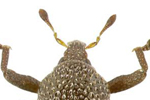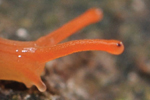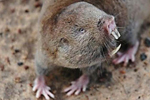From 2000-2009, scientists described on average seven new bird species worldwide every year. Discovering a new bird is one of the least common of any species group, given that birds are highly visible, mobile, and have been scrutinized for centuries by passionate ornithologists and birders. But descriptions this year already blows away the record year over the last decade (in 2001 when nine new birds were described): scientists working in the southern Amazon have recorded an incredible 15 new species of birds according to the Portuguese publication Capa Aves. In fact, this is the largest group of new birds uncovered in the Brazilian in the Amazon in 140 years.
“Describing new species is not a trivial task,” Luis Silveira, of the University of São Paulo, told Wired. “We considered a bird as a new species when at least two of the three criteria—plumage, voice, and genetics—were consistently different from some previously known and closely related, already described species.”
Currently, scientists haven’t released the scientific names and ranges of all of the new birds species. Descriptions of the new species are expected later this month and in July in a special series in the Handbook of the Birds of the World. Some of the species lack photographs, but will appear in illustrations instead.
“If you publish […] each paper separately in different magazines, impact would not be the same,” Silveira told Capa Aves.
Discovered in Brazil’s southern Amazon (including the states of Amazonas, Pará, Acre, Rondônia and Mato Grosso), 11 of the new species are known only from Brazil’s forests, while four others can be found in parts of Peru or Bolivia as well. The new species include four woodcreepers, five antbirds, three tyrants, one puffbird, one gnatcatcher, and one crow, and in total represent a 1 percent growth in Brazil’s known birds.
Unfortunately, four of the new species are believed to be already threatened with extinction, including the new crow. Deforestation is rampant in this part of the world, and many of the new species depend on specialized habitat that could quickly be extinguished.
“The [new crow’s] habitat is in danger and we [may] lose the species before [we] had time to study it thoroughly,” Mario Cohn-Haft, a researcher at the National Institute for Amazonian Research (INPA), told Capa Aves.
Cohn-Haft says that the birds are tell-tale signs of the incredible biodiversity of the imperiled Amazon.
“Even [with the Amazon] having one of the best known groups of birds, discovering new species ‘under our noses’ draws attention to the wealth of the forest. The Amazon continues to offer surprises, far beyond what we imagined,” she says.

Scientists have discovered a new species of puffbird in the Brazilian Amazon. This is a collared puffbird (Bucco capensis) in Yasuni National Park in the Ecuadorian Amazon. Photo by: Jeremy Hance.
Related articles
Chewbacca bat, beetle with explosive farts among oddities spotted on Mozambique expedition

(06/04/2013) The ‘Chewbaka’ bat, a cave-dwelling frog, and a diminutive elephant shrew were among hundreds of species documented during a one-month survey of a park that was ravaged during Mozambique’s 17-year civil war. The findings suggest that biodiversity in Gorongosa National Park in Central Mozambique is well on the road towards recovery, opening a new chapter for the 4,000-square-kilometer protected area.
Scientists describe over 100 new beetles from New Guinea

(06/03/2013) In a single paper, a team of researchers have succinctly described 101 new species of weevils from New Guinea, more than doubling the known species in the beetle genus, Trigonopterus. Since describing new species is hugely laborious and time-intensive, the researchers turned to a new method of species description known as ‘turbo-taxonomy,’ which employs a mix of DNA-sequencing and taxonomic expertise to describe species more rapidly.
Two new arachnids discovered in Brazilian caves (photos)
(05/29/2013) Scientists have discovered two new species of short-tailed whipscorpions (in the order Schizomida) in limestone caves in Brazil, according to a new paper published in PLoS ONE. The new species—dubbed Rowlandius ubajara and Rowlandius potiguara—add new knowledge to a group of arachnids that is little known in South America outside of the Amazon.
Scientists discover two mini-spiders in China (photos)

(05/23/2013) Scientists have uncovered two miniature spiders living on mountains in China’s southern region, one of which is among the smallest spiders recorded worldwide, according to a new paper in ZooKeys. Both spiders belong to the Mysmenidae family, which is made up of mini-spiders with eight eyes.
Three new species of carnivorous snails discovered in endangered habitat in Thailand (photos)

(05/23/2013) Scientists from Chulalongkorn University, Bangkok and the Natural History Museum, London recently discovered three new species of carnivorous snails in northern Thailand. However, the celebration of these discoveries is tainted by the fact that the new snails are already threatened with extinction due to the destruction of their limestone habitat.
Pictures: Top 10 new species of 2012
(05/23/2013) A glow-in-the-dark cockroach, an insect described from a photo posted on Flickr, a monkey that has been likened to Jesus, a carnivorous sea sponge, and the world’s tiniest frog are among the ‘top 10’ species discovered during 2012, according to global committee of taxonomists.
New prehistoric animal named after Johnny Depp due to its ‘scissorhands’

(05/19/2013) Half a billion years after an arthropod with long triple claws roamed the shallow Cambrian seas, scientists have named it after Hollywood movie actor, Johnny Depp: Kooteninchela deppi. Depp, known for his versatility as an actor, played Edward Scissorhands—an artificial man with long scissors for hands—in a popular 1990 film.
Scientists discover new giant mole rat in Africa (photos)

(04/30/2013) Although the term “giant mole rat” may not immediately inspire love, the mole rats of Africa are a fascinating bunch. They spend practically their entire lives underground building elaborate tunnel systems and feeding on plant stems. This underground lifestyle has led them to evolve small ears, tiny eyes, forward-pointing teeth for digging, and nostrils they can shut at will while digging. Some species are quite social, such as the most famous, the naked mole rat (Heterocephalus glaber), while others live largely solitary lives. If that’s not enough, the family of mole rats, dubbed Blesmols, may even help us find a cure for cancer.